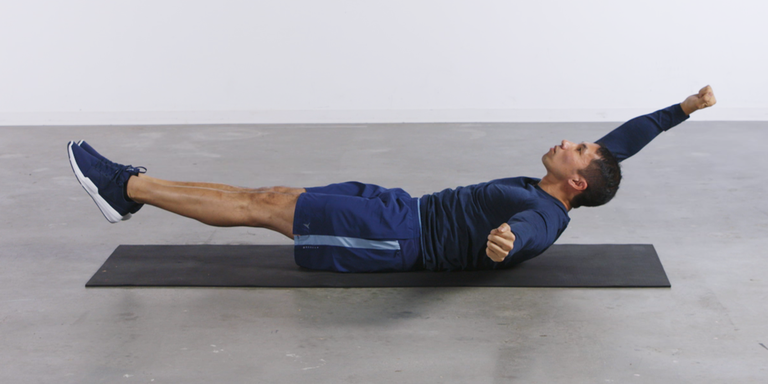How to Master the Hollow Hold for a Stronger Set of Abs
CORE TRAINING IS far too often misunderstood. The default plan for lots of guys is to crank through situp reps—but that only trains one function of the core, trunk flexion, and it's easy to get sloppy with form as the reps pile up. You'll need other exercises to build strong, functional core muscles. That's where the hollow hold comes into play.
The hollow hold is a super simple (but surprisingly difficult) exercise that allows you to hone core bracing, another of the key functions of the muscle group. This fundamental movement is a common staple for gymnasts, as they hone core strength and posture.
Let Men's Health fitness director Ebenezer Samuel, C.S.C.S. and senior editor Brett Williams guide you through the exercise's subtleties, saving you from the bad habits that are keeping you from unlocking your fitness potential.

How to Do the Hollow Hold
Start lying down on your back. Drive your lower back into the floor by flexing your abs, eliminating any space between yourself and the floor.
Lift your feet about two inches off the floor. Continue squeezing your abs to drive your lower back into the ground.
Lift your shoulder blades off the floor and extend your arms back behind you. Contract your abs to hold your rib cage in.
Hold this position, continuing to squeeze your abs and glutes.:Follow along for some higher-level tips from Samuel to dive deeper into the exercise.
Lower Back Presses to the Ground
Eb says: This is the key to the hollow body. Even if you modify the move to make it easier, what makes the hollow body work is the act of pressing your lower back aggressively into the ground. You can only do this by aggressively flexing your abs, and never letting that flex go.
Some ab moves, like situps, can cause a level of spinal flexion, but don't worry about that in the hollow body. The flat ground upon which you're lying will prevent your spine from over-flexing. Use that to your advantage and really flex your abs into the ground.
Shoulder Blades Off the Ground
Eb says: When it comes to upper body position, don't think arms off the ground—focus on shoulder blades off the ground. It's easy to get your arms off the ground, but that doesn't create any tension on your core.
To create tension on your core you need an upper-body lever directly connected to your core. You get that by raising your shoulder blades off the ground. You don't need to elevate your shoulder blades a lot; a millimeter will do. Just don't fall into the trap of thinking you're cruising through the hollow body—because your shoulder blades are comfortably on the ground.
Don't Tuck Your Chin
Eb says: It gets tempting to tuck your chin to your chest on this one, because you might think it'll help you keep your shoulder blades off the ground—but you need to resist that urge.
There are multiple reasons for this. First off, you're taking your neck out of its normal, neutral alignment. Keeping it in place will reduce any chances of neck strain. Secondly, by tucking your chin, you reduce the strain on your core, which suddenly has a little less weight to balance. Don't shortchange yourself like that. Keep your chin in neutral and look upwards as you hollow body.
Benefits of the Hollow Hold
The hollow hold is such an effective exercise because you're working on bracing, one of the key functions of the core. The position also reinforces proper posture.
Muscles Trained By the Hollow Hold
You'll train your whole core—your transverse abdominis, obliques, rectus abdominis, and lower back muscles, too.
How to Scale the Hollow Hold
Having a tough time getting into the hollow hold position? You can make it slightly less difficult by shortening the levers you're working with—in this case, your arms and legs. Samuel notes that you can bend your knees and shift the angle of your arms forward (essentially, into a dead bug position). Just make sure that you keep squeezing your abs and driving your lower back into the floor.
How to Add the Hollow Hold to Your Workouts
You can program the hollow hold into any type of workout, on any day. Samuel recommends working up to three to four rounds of 45 second to a minute-long holds. Just remember that tension is key—if you don't feel like your core is working hard, you're likely not doing the movement properly. Readjust and make sure your form is on point.
Hollow Hold Variations
After you master the basic form, give these variations a shot.
Weighted Hollow Hold
You'll perform the movement exactly the same—but you'll hold a weight plate or small dumbbell in your hands for an extra challenge.
Uneven Hollow Hold
Add an anti-rotation challenge here by forming an L-shape with your arms, with one extended overhead, one out to the side.
Hollow Body Rock
Get moving here, which will challenge you to remain in perfect posture. Once you're in hollow hold position, rock yourself forward, then back, keeping tension.
Gator Roll
This variation is even tougher. Once you're in the hollow hold position, shift to the right and roll over. Maintain tension and hold your position the whole time. After holding for a beat, roll back to the left.
You Might Also Like

